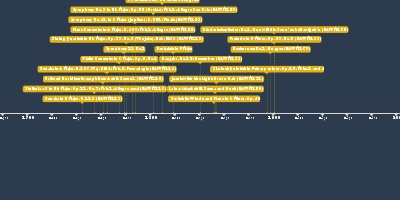jan 1, 1840 - Dichterliebe, Op. 48: No. 1, Im Wunderschonen Monat Mai (NAWM 130)
Description:
Composer: Robert SchumannGenre: Song Cycle
Translation: A Poet’s Love; In the Marvelous Month of May
1840 is commonly titled Schumann's “lieder year”, having composed in it over 120 songs.
This song cycle contains sixteen songs set to poems selected from Heinrich Heine’s Lyrisches Intermezzo, and he arranged the poems to suggest a narrative of remembering and reflecting upon a love affair (initial longing, heartbreak, resignation). Composed four months before he and Clara Wieck were married, he was in a nasty legal battle with her father who was trying to prevent the marriage. This could have contributed to his inspiration for this song cycle.
In the Marvelous Month of May:
Form:
It has two stanzas that each begin with the same line and contain the same rhymes. Parallelism of textual form and ideas prompts Schumann’s setting in a written-out strophic form, framed by a piano prelude that returns as an interlude and postlude.
Poem vs. Music:
The poem happily describes spring time and a newly confessed love, but dissonances and tonal ambiguity give the music a sense of unfulfilled longing (the song's first harmony is a M7). Bursting buds and singing birds of spring are prominent in the poem but not even hinted at in the music. Such irony is typical of Schumann.
Musical Features:
Appoggiaturas and suspensions (some left unresolved) that begin almost every other measure reflect the bittersweet anxiety of the lover.
It never commits to a tonality: The piano prelude half cadences in F# minor, the first two vocal lines cadence in A major, next line moves to B minor, stanza ends on D major, and the song closes on unresolved dominant seventh of F#. This lack of resolution prolongs feelings of Sehnen und Verlangen (longing and desire).
Beginning with what sounds like a middle and ending without resolution makes the song seem like a fragment, and the double cycle through a series of chords that never reach a final resolution suggests the possibility of circling around endlessly reflecting the unfulfillable longing of the lover. A fragment is a quintessentially Romantic idea the Schumann cultivated in many of his works.
In this song, the piano is equal to the voice and is perhaps even the leading partner since it contains the greater part of the musical fabric. Because the true melody is shared between the piano and the voice, the individual lines in the piano and melody are themselves also fragments. The polyphonic thinking of Bach is evident in the ways contrapuntal voices emerge from the texture.
Added to timeline:
Date:
jan 1, 1840
Now
~ 185 years ago
